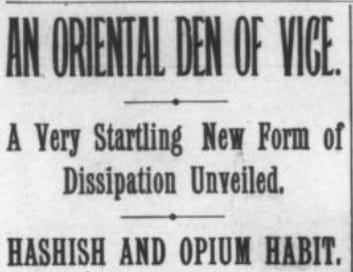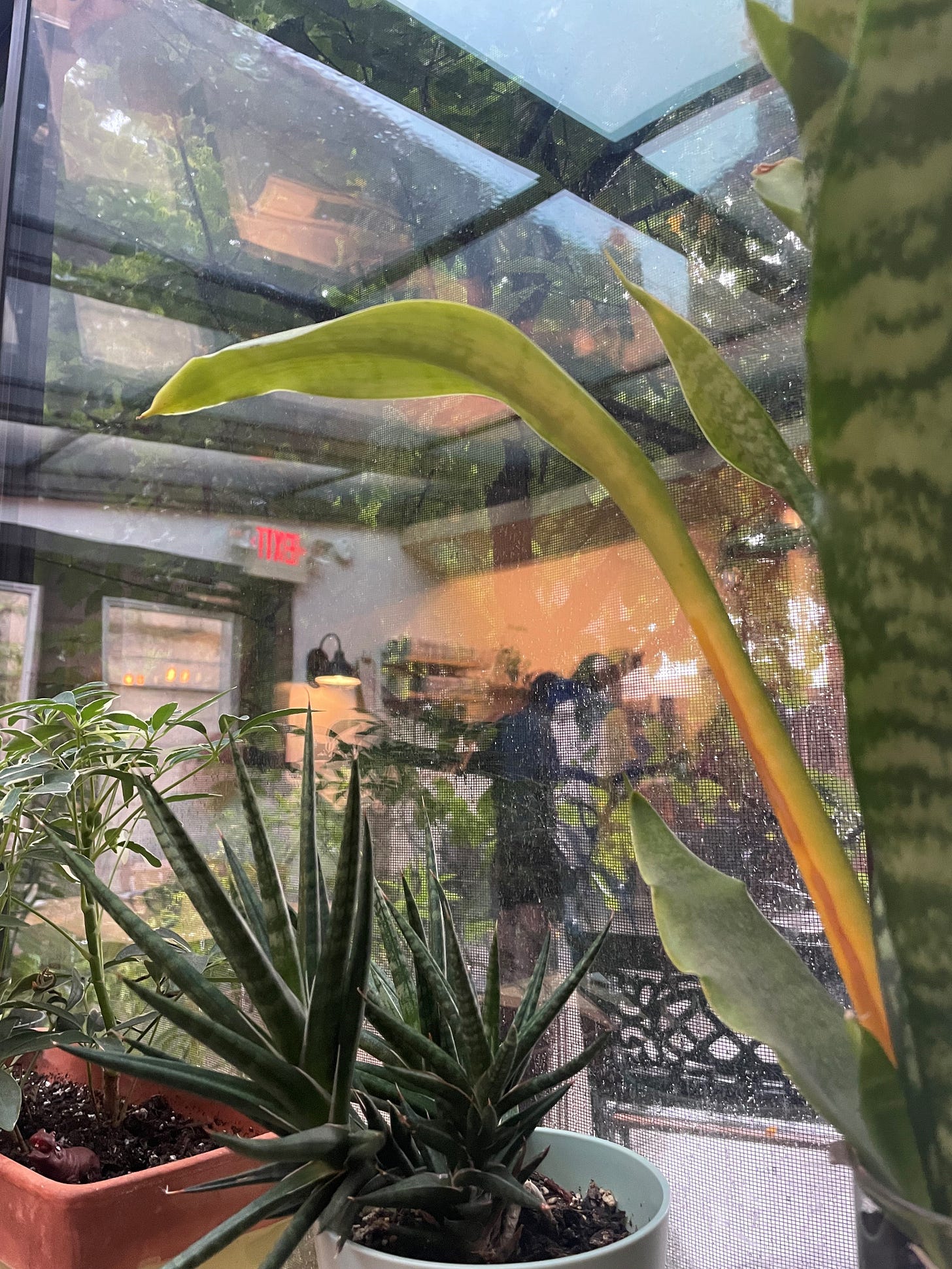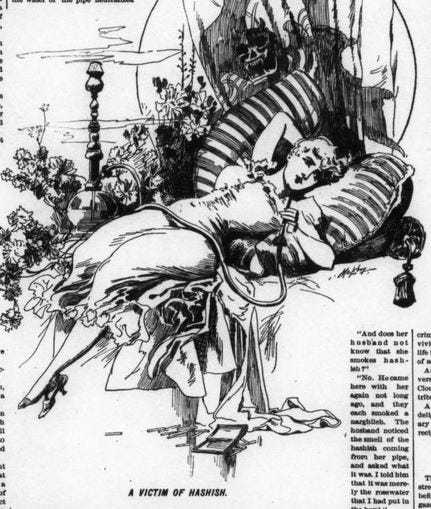07. Cafes in the Rain and a Final Post on Jack Herer's Hashish Parlors
Plus: I win a jelly donut!
Dear Readers,
It’s raining, so I came down to the neighborhood cafe for an espresso. You know what that means: I am blatantly violating my personal commitment to “Radical Moderation,”™ as this is coffee-dose #2 of the morning. I will pay a price I’m sure. But it always seems worth it to drink coffee at the cafe on a rainy day.
I once heard Stephen Malkmus of the band Pavement explain that he moved to Portland, Oregon because the idea of people sitting around at cafes on rainy days appealed to him. I totally get that. It’s great.
Notice how “set and setting” just made me do something ill-advised with drugs. I’ll probably have insomnia tonight. But there are worse things.
Hold on—we’ve got breaking news . . .
Dale Gieringer, noted drug scholar and longtime head of California’s branch of the National Organization for the Reform of Marijuana Laws, just responded to my last post. And he has a delicious nugget of historical evidence for us!
You may remember that on Wednesday I bet a jelly donut that the following image, which Jack Herer claimed was a “hashish parlor,” probably had nothing to do with hashish:
Here’s Dale from the comments:
Isaac, you win a jelly donut. The "Turkish Smoking Parlor" pictured in the New York Herald (Apr 28, 1895) was definitely not a hashish parlor as Jack Herer claimed. Here is what the text of the article says: (excerpt) "Several dark skinned men, who say they are Turks, hailing from Bagdad, but who are sometimes called Armenians, have given New York a new form of dissipation, and New York has taken to it most kindly. In fact, 'hitting' the narghileh, or bubble-pipe, has become a fad . . . The men from Bagdad do not sell liquor, and their Turkish tobacco smoked in pipes of extraordinary length, is no more intoxicating than their black coffee and Persian tea. Persons with jags or jimmies visible to the naked eye cannot enter.
Thank you, Dale! Just as I suspected. And that’s a great reminder for all of us: make sure to leave your jags and jimmies at home today!
You’re now surely wondering what jags and jimmies are. Me too. At first I suspected weapons, but Dale thinks they refer to being intoxicated or hungover. Dale’s theory is growing on me. If anyone else has additional thoughts on this, please leave them in the comments.
Whatever the case, this provides a perfect segue into our final installment of this three-part series on Jack Herer and his historical distortions. Last time we left off with the following Herer assertion: “The Police Gazette estimated there were over 500 hashish smoking parlors in New York City in the 1880s.”
Another doozy? Sadly, yes.
Now, I must confess that I did not know what The Police Gazette was before I wrote this post. It sounds like it must be the official bulletin of the NYPD or something. But since Herer offers no citation, I had to google it. Here’s Wikipedia with what is, as you will see, a highly accurate description:
Ostensibly devoted to matters of interest to the police, it was a tabloid-like publication, with lurid coverage of murders, Wild West outlaws, and sport. It was well known for its engravings and photographs of scantily clad strippers, burlesque dancers, and prostitutes, often skirting on the edge of what was legally considered obscenity.
Ok, so not exactly an impeccable historical source. But thanks to the wonders of the internet, specifically the Internet Archive, we can still take a look from the comfort of our living rooms, or, in my case, the corner seat at Collective Espresso on a rainy morning.
Typing in a search for the 1880s now . . .
Hmm. Not a whole lot of hashish in that decade. Just one article uses the word “hashish” (or “hasheesh”), and that was simply a passing reference to our old friend Fitz Hugh Ludlow and his by-then-well-known book, The Hasheesh Eater.
So let’s broaden the parameters a bit to include the 1890s . . .
Weird. Still, only two articles. Both appeared in the spring of 1895. One, on Saturday, March 30, and this gem from Saturday, April 13:
Shocking! Not only could you get both the opium and hashish “weeds,” but the place was presided over by pretty women! My God!!
Now, to really get a feel for the Police Gazette, I recommend you click on that first link and then flip to page 4.
WARNING!!! NOT SAFE FOR WORK!!
“A pretty living picture whose features and faultless contours cannot be excelled!”
The next page gets even wilder: “Girls in Boxing Gloves!”
This was pretty sleazy stuff for the Gilded Age.
But the hashish articles are actually really useful for our ongoing inquiry, as they follow the same basic script of Harry Hubble Kane’s 1883 “A Hashish-House in New York,” which we examined last time— they identify a single, apparently exceptional location where hashish was supposedly indulged in with an orientalist fetish, and they present that information with the obvious intention of shocking their audience. These articles, in short, are perfectly consistent with all the sources we’ve looked at so far in suggesting that, while recreational cannabis use existed in the United States in the late nineteenth century, it was still pretty rare and exotic.
Now, perhaps the Police Gazette did at some point assert that “500 hashish smoking parlors” existed in New York City. That issue could simply be missing from the Internet Archive’s collection. It’s possible. But even if that were the case, a serious historian would be very dubious given all the other available evidence, including evidence from the Police Gazette itself.
Not to mention that the Police Gazette, while boasting a name that sounds serious, was clearly not a serious publication. Though 99% of Herer’s readers wouldn’t know that, and he of course made absolutely no effort to clarify things for them.
This is how conspiracy theories are born, people.
I suspect that Herer just invented the reference to “500 hashish smoking parlors.” He was very much given to just making stuff up. Plus, by his own admission, he was usually very, very stoned. Theoretically, that might also have had something to do with it.
I can relate. One night, back before cellular technology had taken over, I was doing some scientific experimentation with cannabis when I realized I’d misplaced my cordless telephone.
Luckily the charging station had a handy little button for just such an occasion. When you pressed it, the phone would ring so that you could easily locate it. I pressed the button. I then heard it ringing in the bedroom of our 500-square-foot, one-bedroom shit-box apartment in Somerville, Massachusetts. But by the time I walked into the bedroom and found the phone, I’d completely forgotten how the whole endeavor had started. So of course I picked up the receiver, put it to my ear, and like an idiot said: “Hello?”
That’s what drugs will do to you! Say no to drugs!
I do wonder if Herer knew how badly he was misrepresenting the sources. I suspect that he just felt so strongly about the injustice of cannabis prohibition that he developed a really bad case of what I refer to in my classes as Historical Thinking Deficit, or HTD. If you are ever tempted to ignore evidence simply because it contradicts your politics or ideology, you may have a mild case of HTD. Though if you’re given to just making shit up for the same reasons, it might require immediate attention at the nearest institution of higher learning.
Whatever the case, I think it’s safe to say that, at least until the twentieth century, recreational cannabis use was relatively rare in the United States. And, as I’ve already suggested, people getting WAY TOO STONED probably had something to do with that.
But in the early twentieth century the practice of smoking cannabis started to catch on. And as people started smoking instead of swallowing their “weed,” the results were surely more predictable and pleasant. That probably explains, at least in part, the growth of recreational cannabis use in the early-twentieth-century United States.
Though there were other factors that we’ll eventually consider. But it’s the end of the week. And raining. And I’m overcaffeinated.
I wish you a pleasant weekend.









To your point Dr. Campos - "Notice how “set and setting” just made me do something ill-advised with drugs." Indeed. We see this around us in all walks of life. "I only do [insert vice here] when I..." The guys who only smoke giant cigars while playing golf. Then there's the people who only drink to excess before noon when tailgating for a 12 o'clock kick off football game. When people used to be able to smoke indoors it was always the "Well, I'm not a smoker of course, but can I bum a cigarette - I only smoke when I'm out at the bar." Those are all more social functions, but it evolves in the workplace as well; for example, many decades ago I had occasion to spend time with military people in their field training environments, and you often heard "Oh, I only smoke when I'm in the field" or "Or, I only dip (using a smokeless tobacco for those not in the know) when in the field" or "I only drink coffee when I'm deployed." All sorts of things were done "in the field" or while "deployed" that were never done at home (e.g., while not a drug, growing one's mustaches were often en vogue.) The setting, then, in many cases really does seem exceedingly important to individual choices about what drugs are appropriate and not. Indeed, this causes me to recall that I once had a young woman acquaintance of publicly good morals and character in all respects who readily chewed a brand of leaf tobacco called 'Red Man' on the opening day of whitetail deer hunting season (which in my very rural upbringing was a major event for all.) This of course was the ONLY time of year her dabbling in this form of tobacco happened and was not spoken of at any other time. Appropriate drug and setting for the consumption, any other time why it just wouldn't have been socially acceptable. Good day to you.